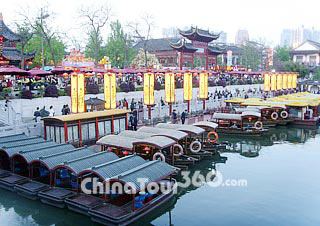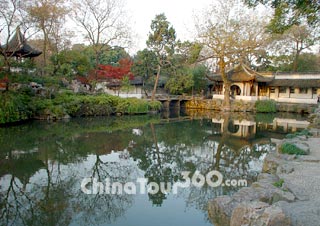 Nanjing Confucius Temple
Nanjing Confucius Temple Xuzhou Han Terracotta Warriors
Xuzhou Han Terracotta Warriors The Humble Administrator''s Garden
The Humble Administrator''s Garden Xuzhou Guishan Han Mausoleum
Xuzhou Guishan Han Mausoleum
Jiangsu Province, located in East China and the lower reaches of the Yangtze River and Huai River, borders Shandong in the north, Anhui to the west, and Zhejiang and Shanghai to the south. With an area of 102,600 square kilometers (39,614 square miles) and a population of 74.058 million (2003), Jiangsu is well known as 'a land flowing with milk and honey' and has been a tourist paradise for a long time.
During the earliest Chinese dynasties, the area in what is now Jiangsu was far removed from the center of Chinese civilization. It was during the Song Dynasty (960 - 1279), which saw the development of a wealthy mercantile class and emergent market economy in China that south Jiangsu emerged as a center of trade. From then on, it would be synonymous with opulence and luxury in China. Especially the capital city, Nanjing, brags a fascinating history and it was the capital of eight Chinese dynasties.
Jiangsu is very flat and low-lying; with plains covering 68 percent of its total area (water covers another 18 percent). With three main river systems from north to south - the Yishu River, the Huai River and the Yangtze River, and dotted with Tai Lake and Hongze Lake which are among the top five freshwater lakes in China, Jiangsu has well-developed irrigation systems and shipping. The well-known Grand Canal also runs through the entire province from north to south. Jiangsu Province thus enjoys the superiority of its natural condition and lays a solid economic foundation.
Spanning the warm-temperate and subtropical climate zones, Jiangsu has mild weather and moderate rainfall. The climate here is damp and four seasons are clear, with temperatures at an average of -2 to 4 degrees Celsius (28.4 to 39.2 degrees Fahrenheit) in January and 26 to 30 degrees Celsius (78.8 to 86 degrees Fahrenheit) in July. There are frequent 'plum rains' between spring and summer, and typhoon rains between late summer and early autumn.
Jiangsu Province is home to one of the most extensive transportation networks in China and rich in cultural traditions. All of these make Jiangsu a perfect destination to tourists. Rich in landscape gardens, scenic attractions and historical sites, it is noted for having the largest number of historical cities in the country. Nanjing, Suzhou, Yangzhou, Zhenjiang, Changshu, Xuzhou and Huaian are famous historical and cultural cities. Sixteen cities in the province have been entitled Fine Tourist Cities in the country, including Nanjing and Suzhou, the Paradise on the Earth. There are now 20 well-known scenic spots, 23 forest parks, 6 tourism and holiday resorts and 461 historical sites under state and provincial protection. Nine classical gardens in Suzhou are designated by UNESCO as world cultural heritage.







